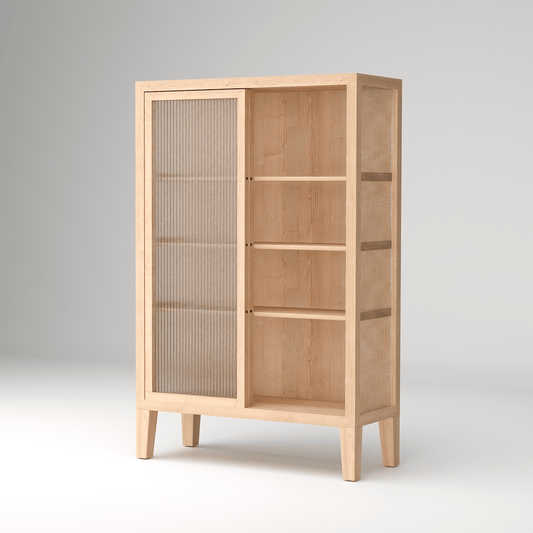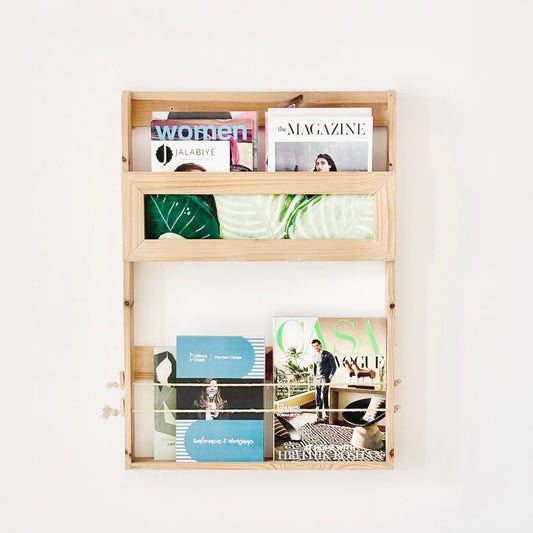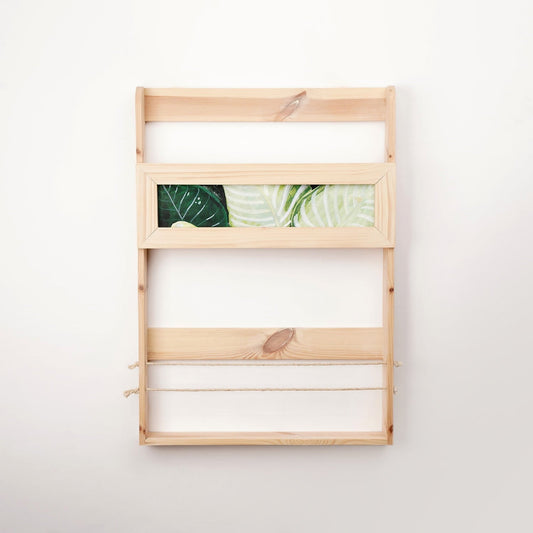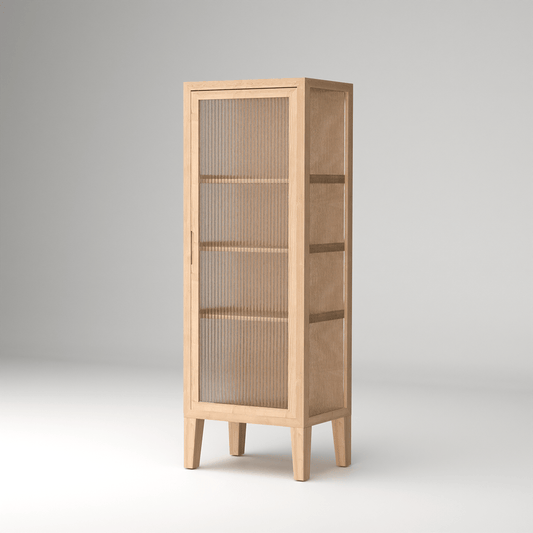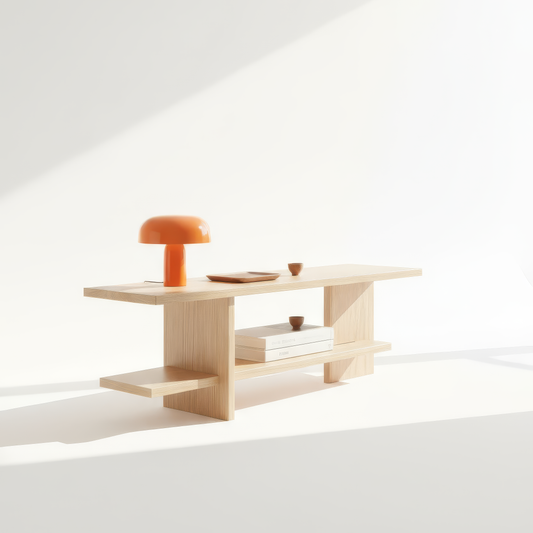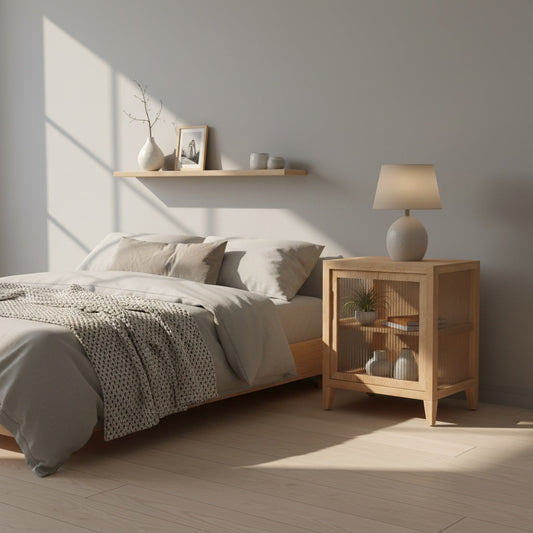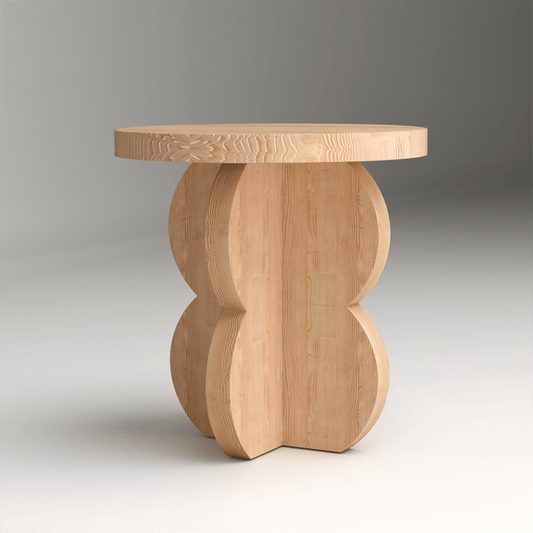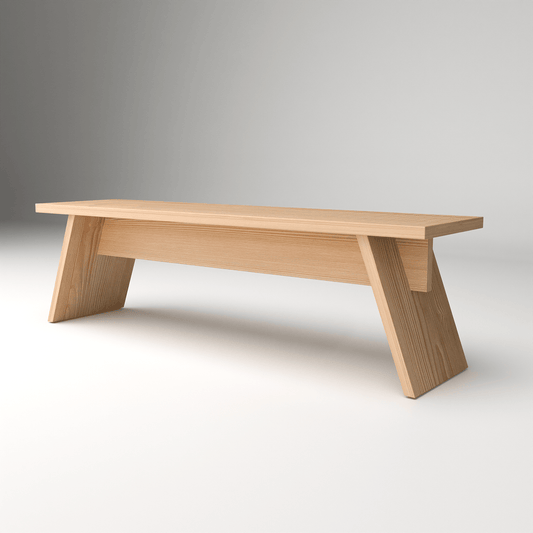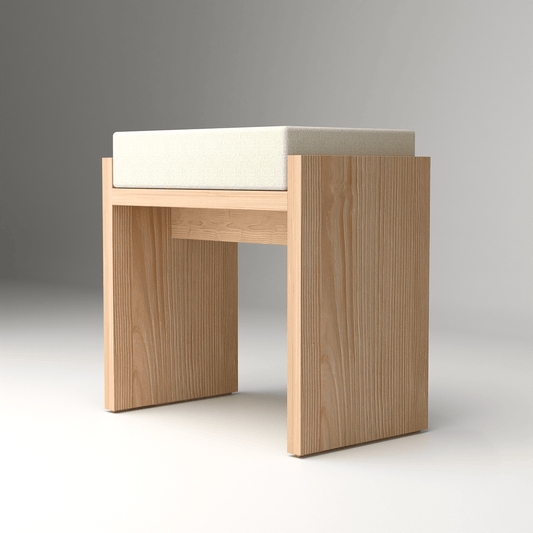Creating a perfect sanctuary through Scandinavian design in 2025 means embracing a holistic approach that goes far beyond aesthetic choices to encompass emotional well-being, environmental responsibility, and genuine comfort. This evolution of Nordic design principles recognizes that our homes should serve as restorative retreats from the complexities of modern life—spaces that actively support our mental, physical, and spiritual well-being.
At A Good Life, we understand that creating a sanctuary isn't about following prescribed design rules but about crafting spaces that truly reflect your needs and values. Our handcrafted pine wood furniture serves as the foundation for these personal sanctuaries, providing the natural warmth and authentic character that make spaces feel genuinely nurturing.
Understanding the Sanctuary Concept in Nordic Design
The concept of home as sanctuary has deep roots in Scandinavian culture, where long winters and limited daylight have historically made the home environment crucial for psychological survival and community connection.
The Evolution of Nordic Sanctuary Design
Traditional Scandinavian homes served as literal sanctuaries from harsh weather conditions. The 2025 interpretation expands this concept to include sanctuary from:
-
Digital overwhelm and constant connectivity
-
Environmental stressors and pollution
-
Social pressures and performance anxiety
-
Economic uncertainty and material excess
-
Physical discomfort and ergonomic strain
Core Sanctuary Principles
Restorative Environment: Spaces designed to actively promote recovery from daily stress and fatigue.
Authentic Materials: Natural elements that connect inhabitants to the natural world and provide sensory grounding.
Flexible Functionality: Adaptable spaces that can serve different needs throughout the day and seasons.
Personal Reflection: Design elements that reflect individual values, memories, and aspirations.
Sustainable Practices: Choices that align personal well-being with environmental responsibility.
Foundation Elements: Building Your Sanctuary Base
Creating a Scandinavian sanctuary begins with establishing foundational elements that provide stability, comfort, and visual calm.
Essential Sanctuary Furniture
Comfortable Seating: Pieces that invite relaxation and support various postures and activities.
Flexible Storage: Solutions that maintain visual calm while accommodating the practical needs of daily life.
Natural Surfaces: Tables, shelves, and other surfaces that showcase the beauty of natural materials.
Restorative Lighting: Fixtures and systems that support circadian rhythms and create appropriate atmospheres for different activities.
Our Solid Wood Narrow Hallway Table exemplifies sanctuary design principles, providing a welcoming entry point that sets the tone for the entire home. This piece combines practical functionality with the visual warmth of natural pine wood, creating a transitional element that helps separate the outside world from your personal sanctuary.
Color Psychology for Sanctuary Spaces
The 2025 approach to sanctuary color focuses on psychological impact and emotional support rather than purely aesthetic considerations.
Sanctuary Color Framework
Grounding Neutrals: Warm beiges, soft grays, and cream tones that provide psychological stability and calm.
Nature-Inspired Accents: Muted greens, earth browns, and sky blues that connect interior spaces to natural environments.
Seasonal Adaptations: Color adjustments that respond to changing light conditions and emotional needs throughout the year.
Personal Significance: Colors that hold positive associations and memories for the inhabitants.
Color Application for Well-Being
-
Use lighter colors in spaces where energy and alertness are desired
-
Incorporate deeper, warmer tones in areas designated for rest and relaxation
-
Balance cool and warm colors to prevent spaces from feeling too sterile or too overwhelming
-
Consider the psychological impact of color combinations on mood and stress levels
-
Allow natural wood tones to serve as neutral anchors that ground more saturated colors
Lighting Design for Sanctuary Atmosphere
Lighting plays a crucial role in creating the restorative atmosphere essential to sanctuary spaces.
Sanctuary Lighting Strategies
Circadian Support: Lighting systems that adjust throughout the day to support natural sleep-wake cycles and seasonal mood regulation.
Activity-Specific Illumination: Different lighting scenarios for work, relaxation, socializing, and rest.
Natural Light Maximization: Strategic placement of furniture and reflective surfaces to make the most of available daylight.
Candle Integration: The irreplaceable warmth and psychological comfort of flickering flame light.
Dimming Capabilities: The ability to adjust light levels to match energy levels and activities throughout the day.
Furniture Arrangement for Sanctuary Flow
The way furniture is arranged significantly impacts how a space feels and functions as a sanctuary.
Sanctuary Arrangement Principles
Clear Pathways: Movement routes that feel natural and unobstructed, reducing daily stress and promoting calm.
Conversation Areas: Seating arrangements that facilitate meaningful connection with family and friends.
Solitude Zones: Spaces designated for individual reflection, reading, or quiet activities.
Flexibility: Arrangements that can be easily adjusted for different activities and social situations.
Natural Focal Points: Using windows, fireplaces, or beautiful furniture pieces as anchors for room arrangements.
For versatile seating that supports sanctuary principles, consider our Minimalist Solid Wood Bare Edge Bench. This piece can serve multiple functions—additional seating for gatherings, a meditation bench for quiet reflection, or a surface for displaying meaningful objects—while maintaining the clean lines essential to sanctuary aesthetics.
Storage Solutions for Sanctuary Maintenance
Maintaining the calm atmosphere essential to sanctuary spaces requires thoughtful storage solutions that keep clutter at bay.
Sanctuary Storage Principles
Hidden Organization: Storage solutions that maintain visual calm while providing practical organization.
Beautiful Functionality: Pieces that serve storage needs while contributing to the space's aesthetic appeal.
Accessible Systems: Organization that makes it easy to maintain order without stress or complexity.
Natural Materials: Storage solutions that complement rather than compete with the sanctuary aesthetic.
Flexible Capacity: Systems that can adapt to changing storage needs over time.
Biophilic Design for Sanctuary Connection
Connecting sanctuary spaces to nature through biophilic design principles supports both psychological well-being and environmental awareness.
Natural Element Integration
Living Plants: Carefully chosen plants that thrive in your specific conditions and contribute to air quality and psychological well-being.
Natural Materials: Wood, stone, ceramic, and other materials that age beautifully and provide sensory connection to nature.
Organic Shapes: Furniture and accessories that echo natural forms rather than purely geometric designs.
Natural Patterns: Textures and patterns that reflect those found in natural environments.
Seasonal Elements: Incorporating elements that change with the seasons to maintain connection to natural cycles.
Technology Integration in Sanctuary Spaces
Modern sanctuary design must thoughtfully integrate necessary technology while maintaining the calm atmosphere essential to restorative spaces.
Sanctuary-Compatible Technology
Hidden Infrastructure: Cable management and charging solutions that maintain clean aesthetics while providing necessary connectivity.
Automated Comfort: Climate and lighting systems that adjust automatically to support well-being without requiring constant attention.
Digital Wellness: Design elements that encourage healthy relationships with technology and support digital detox.
Sound Management: Audio systems that can provide ambient music or nature sounds without visible complexity.
Smart Home Integration: Automated systems that enhance comfort and security without disrupting the sanctuary atmosphere.
Personal Touches for Authentic Sanctuary
True sanctuary spaces reflect the personalities, values, and experiences of their inhabitants.
Personalizing Your Sanctuary
Meaningful Objects: Displaying items that tell your story and create emotional connections to place and memory.
Handmade Elements: Incorporating crafted pieces that show human touch and support artisanal traditions.
Family Heritage: Including pieces that connect you to family history and create continuity across generations.
Travel Memories: Thoughtfully displaying items that remind you of meaningful experiences and places.
Creative Expression: Including elements that reflect your hobbies, interests, and creative pursuits.
Our Wabi-Sabi Quote Display Shelf provides the perfect platform for personal expression within sanctuary spaces. This handcrafted pine piece celebrates natural imperfections while offering a beautiful way to display meaningful quotes, small objects, or seasonal elements that reflect your personal journey and values.
Seasonal Sanctuary Adaptations
True sanctuary spaces respond to seasonal changes, adapting to support well-being throughout the year.
Seasonal Sanctuary Elements
Winter Sanctuary: Heavier textiles, warmer lighting, deeper colors, and elements that create psychological warmth during darker months.
Spring Sanctuary: Lighter textiles, increased natural light, fresh plants, and colors that reflect renewal and growth.
Summer Sanctuary: Minimal textiles, maximized natural light, outdoor connections, and elements that create cooling psychological effects.
Autumn Sanctuary: Rich textures, warm colors, harvest elements, and preparations for the introspective season ahead.
Maintenance and Care for Sanctuary Spaces
Maintaining sanctuary spaces requires ongoing attention to both aesthetic and functional elements that support well-being.
Sanctuary Maintenance Strategies
Regular Decluttering: Periodic removal of items that no longer serve the space's sanctuary function.
Seasonal Updates: Changes in textiles, lighting, and accessories to maintain freshness and seasonal connection.
Material Care: Proper maintenance of natural materials to preserve their beauty and sanctuary-enhancing properties.
Energy Management: Attention to the emotional energy of spaces and adjustment of elements that may be creating stress or distraction.
Ritual Integration: Incorporating daily or weekly rituals that maintain both the physical space and its sanctuary atmosphere.
Budget-Friendly Sanctuary Creation
Creating authentic sanctuary spaces doesn't require expensive overhauls or luxury purchases.
Affordable Sanctuary Strategies
Lighting Focus: Candles, warm-bulb lamps, and natural light optimization can immediately transform a space's sanctuary potential.
Textile Comfort: Throws, cushions, and rugs can add comfort and warmth without major investment.
Plant Integration: Affordable plants can add life, air purification, and natural beauty to any space.
Decluttering: Often the most impactful sanctuary improvement costs nothing but time and decision-making.
Rearrangement: Simply repositioning existing furniture can create more sanctuary-friendly arrangements and improve energy flow.
Health and Wellness Through Sanctuary Design
Sanctuary spaces should actively support physical and mental health through thoughtful design choices.
Wellness-Supporting Elements
Air Quality: Materials and plants that contribute to healthy indoor air and respiratory well-being.
Ergonomic Support: Furniture and arrangements that support good posture and physical comfort.
Stress Reduction: Colors, textures, and arrangements that promote relaxation and reduce anxiety.
Sleep Support: Bedroom sanctuary elements that contribute to better rest and recovery.
Social Connection: Spaces that facilitate meaningful interaction with family and friends.
The Future of Sanctuary Design
Looking beyond 2025, sanctuary design will likely continue evolving to address changing lifestyle needs and environmental challenges.
Emerging Sanctuary Trends
Climate Adaptation: Sanctuary design that responds to changing environmental conditions and supports resilience.
Community Integration: Spaces that balance personal sanctuary needs with community connection and social responsibility.
Wellness Technology: Integration of health-monitoring and supporting technologies within sanctuary aesthetics.
Regenerative Design: Sanctuary spaces that actively contribute to environmental healing and restoration.
Cultural Integration: Incorporation of sanctuary traditions from various cultures within Nordic frameworks.
Creating your perfect Scandinavian sanctuary in 2025 means embracing a holistic approach that considers not just how spaces look, but how they make you feel and how they support your overall well-being. By focusing on natural materials, thoughtful lighting, comfortable arrangements, and personal meaning, you can create spaces that truly serve as refuges from the complexities of modern life.
The key to successful sanctuary design lies in understanding that it's not about following prescribed aesthetics, but about creating environments that genuinely support your unique needs and values. As Scandinavian design continues to evolve, this human-centered approach will remain its most important characteristic, ensuring that our homes continue to serve as true sanctuaries for the good life.


